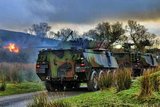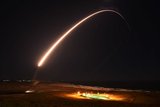SPYDR casts airborne ISR web
L-3 has launched a new ISR system based on its experience gained from the development of Project Liberty.
SPYDR is an equipment package devised for use on the Beech King Air 350 turboprop aircraft capable of collecting full motion video (FMV) and signals intelligence. The company has a King Air testbed and put the aircraft on display at the Royal International Air Tattoo at RAF Fairford, where the SPYDR system is being shown to potential customers for the first time.
'We see this as our third generation ISR system,' says Joe Siniscalchi, VP of strategy at L3's mission integration division.
'This system encompasses some of the lessons learnt during the development of our other systems.'
Particular attention has been made to the ability to queue multiple sensors such as EO/IR, electronic surveillance system or radar onto a target.
'ISR used to be the domain of countries with large defence budgets,' said Siniscalchi, 'but systems like SPYDR are affordable and we can deliver this right now.'
Among the systems on the heavily modified King Air are an MX-15 EO/IR turret fitted to the underside of the aircraft, while on top is a satcom dome for beyond line of sight communications. L-3 have partnered with Selex Galileo to fit that company's Picosar synthetic aperture radar system. L-3 also offer a self-protection system for the aircraft.
The company is also studying the potential to fit a second MX-15 in an extended nose fairing.
The SPYDR testbed is now set to begin a tour which will take it to the Dubai Air Show as well as some customer trials.
More from Digital Battlespace
-
![Babcock nears first customer for Nomad AI translation tool]()
Babcock nears first customer for Nomad AI translation tool
Nomad can provide militaries with real-time intelligence, saving critical time on the battlefield.
-
![AUSA 2025: Israel’s Asio Technologies to supply hundreds of improved Taurus tactical systems]()
AUSA 2025: Israel’s Asio Technologies to supply hundreds of improved Taurus tactical systems
Taurus operates alongside the Israel Defense Forces’ Orion system which supports mission management across tens of thousands of manoeuvring forces, from squad leaders to battalion commanders.
-
![AUSA 2025: Kopin pushes micro-LED plans as China moves faster]()
AUSA 2025: Kopin pushes micro-LED plans as China moves faster
The plan for the new displays follows fresh investment in Kopin’s European facilities by Theon and an order for head-up displays in fielded aircraft, with funding from the US Department of Defense.
-
![AUSA 2025: Persistent Systems to complete its largest order by year’s end]()
AUSA 2025: Persistent Systems to complete its largest order by year’s end
Persistent Systems received its largest ever single order for its MPU5 devices and other systems earlier this month and has already delivered the 50 units to the US Army’s 4th Infantry Division.
-
![Aselsan brings in dozens of companies and systems under the Steel Dome umbrella]()
Aselsan brings in dozens of companies and systems under the Steel Dome umbrella
Turkey has joined the family of countries attempting to establish a multilayered air defence system with government approval in August 2024 for the effort landed by Aselsan. Dubbed Steel Dome, the programme joins Israel’s Iron Dome, the US Golden Dome, India’s Mission Sudarshan Chakra and South Korea’s low-altitude missile defence system.
-
![DSEI 2025: MARSS unveils new agnostic multidomain C4 system]()
DSEI 2025: MARSS unveils new agnostic multidomain C4 system
MARSS’ NiDAR system has been deployed using sensors from static platforms to provide detection and protection for static sights, such as critical infrastructure, ports and military bases.




























